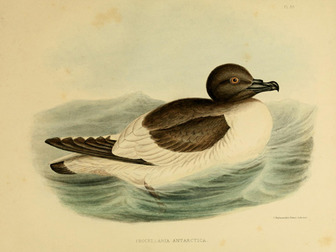Antarctic Petrel
The Antarctic Petrel is the only known species in the genus Thalassoica, and is a member of the Procellariidae family, and the Procellariiformes order. Also, this Petrel along with the Snow Petrel, the Cape Petrel, both Giant Petrels, and the two species in the Fulmarus family, are considered to be a separate group from the other Procellariidae members.

The Antarctic Petrel is classified as Least Concern. Does not qualify for a more at risk category. Widespread and abundant taxa are included in this category.
The Antarctic Petrel, Thalassoica antarctica, is a boldly marked dark brown and white petrel, found in Antarctica, most commonly in the Ross and Weddell seas. They eat Antarctic krill, fish, and small squid. They feed while swimming but can dive well from the surface and the air. More
Physical description: Antarctic petrel have chocolate-brown and white wings with broad white trailing edges. The tail is white with a brownish-black tip. They are a medium-sized petrel with a 100-110 cm wing-span, with an average mass of 675 g. Distribution & Abundance: Antarctic petrel are mainly confined to the vicinity of the pack-ice, icebergs, ice floes, Antarctic seas and the Antarctic continent. Flocks are characteristically seen sitting on the ridges of icebergs. More
Aspects of the topic Antarctic petrel are discussed in the following places at Britannica. Assorted References * breeding habits in Antarctica (in Antarctica: Birds) About 45 species of birds live south of the Antarctic Convergence, but only three—the emperor penguin (see photograph), Antarctic petrel, and South Polar (McCormick’s) skua—breed exclusively on the continent or on nearby islands. More
The Antarctic petrel is a boldly marked dark brown and white petrel, a little smaller than the Antarctic fulmar. They are mostly found in the Ross Sea region. Eggs are laid in November after the adults arrive at their nest sites the previous month. Chicks fledge in March.The rest of the year, the colonies are deserted while the birds stay at sea among and just north of the pack ice. They eat Antarctic krill, fish, and small squid taken by surface-seizing, dipping and shallow diving. More
The Antarctic Petrel (Thalassoica antarctica) is one of those seabirds that birders always hope to see on trips to Antarctica. It can be very hard to find on the regular trips to the Antarctic Peninsula in the summer (December-February) which is when most tour ships visit that region. It does not nest along the peninsula, so birds seen there are visitors. More
Antarctic petrel chick on nest© Michael Whitehead / Auscape International Antarctic petrels nesting© Pete Oxford / naturepl.com Antarctic petrel in flight, dorsal view© Pete Oxford / naturepl.com Antarctic petrel flying, ventral view© Ingo Arndt / naturepl.com Antarctic petrel in flight over sea, side view© Bill Coster / www.nhpa.co.uk Antarctic petrel in flight© Roger Tidman / www.flpa-images.co. More
Antarctic Petrel, and the Snow Petrel form a sub-family within the larger family. The Southern Giant Petrel was first described as Macronectes giganteus by Johann Friedrich Gmelin, in 1789, based on a specimen from Staten Island off Tierra del Fuego. Etymology Macronectes giganteus can be broken down as makros a Greek word meaning long or large and nēktēs meaning swimmer, and giganteus from the Latin for gigantic. More
The Antarctic Petrel is a large petrel with strikingly contrasting plumage colours. It is similar to the cape petrel, Daption capense, but without the speckled upperwing. Antarctic petrels spend the Antarctic winter at sea near the pack ice edge, but sometimes range further north in winter, returning to the Antarctic continent to breed in the summer. They are often seen in flocks, sometimes comprising thousands of birds, on ice floes. In late winter, they are occasionally recorded from Australia and New Zealand. More
second Antarctic Petrel appeared giving good looks for all - a handsome bird indeed. As we progressed southward it grew chillier by the hour and suddenly we were joined by the first Snow Petrels; four birds which fluttered round the ship for some time before flying off. More
Videos and images Antarctic petrel in flight Antarctic petrel in flight Species related by - * Family group * Habitat * Conservation status * * View image slideshow * Link to this image * Email to a friend * More
Antarctic Petrels live and nest exclusively in the Antarctic, spending the winter in the pack-ice. They are mostly found in the Ross Sea region. Return - Southern Fulmar - The Southern or Antarctic fulmar breeds on steep rocky cliffs on the coast of Antarctica and often congregates in large "rafts" on the ocean to rest, or feed on krill. More

Original source: Hiroshi Kanda
Author: Hiroshi Kanda
Permission: Some rights reserved
Family : Procellariidae
Genus : Thalassoica
Species : antarctica
Authority : (Gmelin, 1789)
